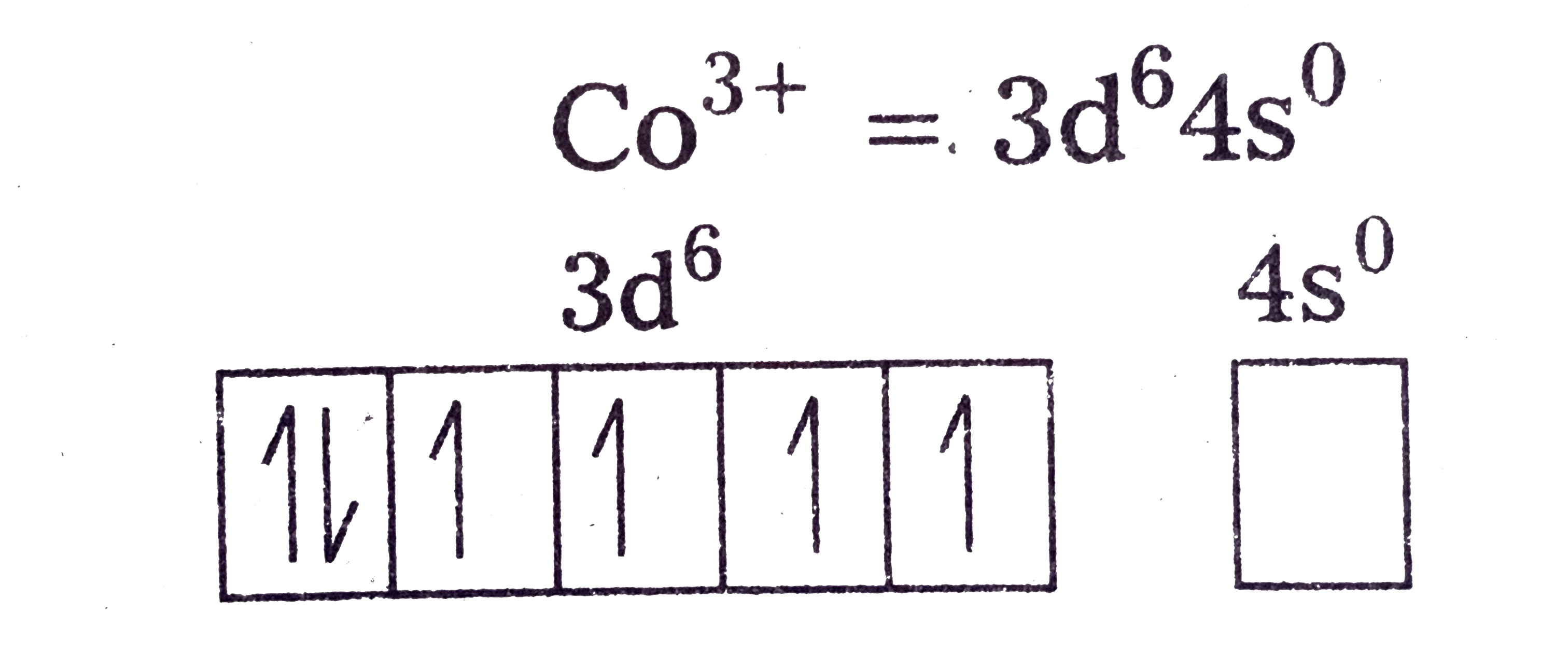Discuss the nature of bonding and magnetic behaviour in the [Co(C2O4)3]3− Co-ordination entities on the basis of valence bond theory.Solution in Telugu
[Co(C2O4)3]3− : In this complex, the oxidation state of Co is + 3.
Outer configuration of Co=3d74s2

Oxalate ion being a strong field ligand pair .up the 3d electrons, thus two out of the five 3d-orbitals are available for oxalate ions.

Since, all the electrons are paired, this complex is diamagnetic. It is an inner orbital complex because of the involvement of (n - 1) d-orbital for bonding,
Topper's Solved these Questions
- D AND F- BLOCK ELEMENTS AND CO-ORDINATION COMPOUNDS Book:VIKRAM PUBLICATION ( ANDHRA PUBLICATION)Chapter:D AND F- BLOCK ELEMENTS AND CO-ORDINATION COMPOUNDS Exercise:INTEXT QUESTIONS
Explore 33 Videos
- D AND F- BLOCK ELEMENTS AND CO-ORDINATION COMPOUNDS Book:VIKRAM PUBLICATION ( ANDHRA PUBLICATION)Chapter:D AND F- BLOCK ELEMENTS AND CO-ORDINATION COMPOUNDS Exercise:SHORT ANSWER QUESTIONS
Explore 57 Videos
- CHEMISTRY IN EVERYDAY LIFEBook:VIKRAM PUBLICATION ( ANDHRA PUBLICATION)Chapter:CHEMISTRY IN EVERYDAY LIFEExercise:Intex questions
Explore 5 Videos
- ELECTROCHEMISTRY & CHEMICAL KINETICSBook:VIKRAM PUBLICATION ( ANDHRA PUBLICATION)Chapter:ELECTROCHEMISTRY & CHEMICAL KINETICSExercise:DAM SURE
Explore 18 Videos
Similar Questions
Silver atom has completely filled d-orbitals (4d10) in its ground state. How can you say that it is a transition element ?
View SolutionCompared to 3d series the corresponding transition metals of 4d and 5d transition series show high enthalpy of atomization. Explain.
View SolutionSleeping pills are recommended by doctors to the patients suffering from sleeplessness but is not advisable to take its doses without consultation with the doctor.Why?
Consider the effect of tranquilizers or antidepressants on the nervous system.
View SolutionDiffine conductivity of a material. Give its SI units.
View Solutionसंयोजकता आबन्ध सिद्धान्त के आधार पर [Co(C2O4)3]3− उपसहसंयोजन यौगिक में बन्ध की प्रकृति बताइए :
View SolutionDiscuss the nature of bonding and magnetic behaviour in the [Fe(CN)_(6)]^(4-) Co-ordination entities on the basis of valence bond theory.
View SolutionDiscuss the nature of bonding and magnetic behaviour in the [FeF6]3− Co-ordination entities on the basis of valence bond theory.
View SolutionDiscuss the nature of bonding and magnetic behaviour in the [CoF6]3− Co-ordination entities on the basis of valence bond theory.
View SolutionDiscuss the nature of bonding in the given coordination entities on the basis of valence bond theory: [Co(C_(2)O_(4))_(3)]^(3-)
View Solutionसंयोजनकता आबंध सिद्धांत के आधार पर निम्नलिखित उपसहसंयोजन सत्ता में आबंध की प्रकृति की विवेचना कीजिये -
[Co(C2O4)3]3−
View SolutionDiscuss the bonding in the coordiantion entity [CO(Nh_(3))_(6)]^(3+) on the basis of valence bond theory . Also , comment on the geometyr and spin of the given entity .
View SolutionDiscuss the nature of bonding in the following coordination entities on the basis of Valence Bond Theory :
[FeF6]3−
View SolutionDiscuss the nature of bonding in the following coordination entities on the basis of Valence Bond Theory :
[Co(C2O4)3)]3−
View SolutionDiscuss the nature of bonding in the following coordination entities on the basis of Valence Bond Theory :
[CoF6]3−
View SolutionDiscuss the nature of bonding in the following coordination entities on the basis of valence bond theory: [FeF6]3−
View Solution